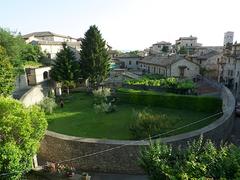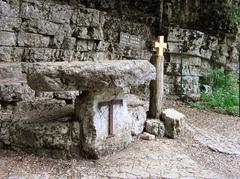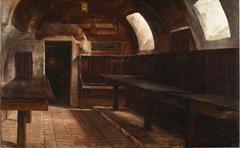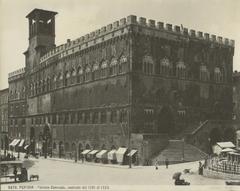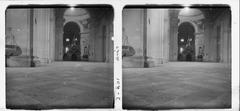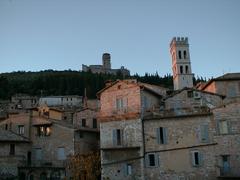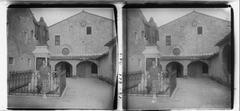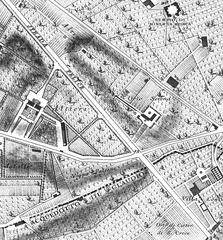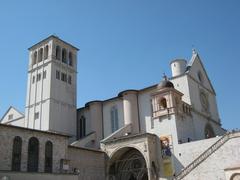Sacro Convento Assisi: Visiting Hours, Tickets, and Historical Guide
Date: 14/06/2025
Introduction: The Sacro Convento’s Heritage and Significance
Located in the heart of Assisi, Italy, the Sacro Convento stands as a monumental testament to Franciscan spirituality, medieval architecture, and Italy’s artistic legacy. Adjoining the Basilica of San Francesco, this complex is both a vital pilgrimage destination and a cultural landmark, attracting millions of visitors each year. Since its founding in the 13th century after the canonization of Saint Francis, the Sacro Convento has grown through papal patronage and artistic innovation, embodying a unique synthesis of faith, history, and art (Italyscapes; sanfrancescoassisi.org).
A visit to the Sacro Convento offers the chance to explore the frescoed Upper and Lower Basilicas, admire masterpieces by Cimabue, Giotto, Simone Martini, and Pietro Lorenzetti, and reflect at the tomb of Saint Francis. The friary remains an active spiritual center, home to a vibrant Franciscan community, and regularly hosts significant religious and cultural events—including the anticipated 2025 exhibition on the legacy of Saint Francis (Assisi Eventi; umbriacronaca.it).
This guide provides a detailed and practical overview for pilgrims, art lovers, and travelers, including historical background, architectural highlights, visiting hours, ticketing, accessibility, and tips for planning your visit.
Contents
- Discover the Sacro Convento: Overview
- Historical and Architectural Background
- Artistic and Cultural Highlights
- Practical Visitor Information
- Visiting Hours
- Tickets and Admission
- Accessibility
- Guided Tours and Events
- Getting There and Facilities
- Nearby Attractions in Assisi
- Frequently Asked Questions (FAQ)
- Visitor Recommendations and Summary
- References
Discover the Sacro Convento: Overview
The Sacro Convento, together with the Basilica of San Francesco, is a spiritual, artistic, and historic gem at the heart of Assisi. Its cloisters, chapels, and museums offer a journey through centuries of devotion, creativity, and Franciscan heritage.
Historical and Architectural Background
Origins and Construction
The Sacro Convento owes its existence to the canonization of Saint Francis in 1228, when Pope Gregory IX authorized a church and friary to safeguard the saint’s remains. The Lower Basilica was built between 1228 and 1230, with the Upper Basilica completed in 1253 (Italyscapes). The earliest sections of the Sacro Convento date from this era, constructed from local limestone, giving the structure its iconic pink and white hues.
The initial complex included the friary, cloisters, and a papal palace designed to host visiting pontiffs and dignitaries. The robust fortifications—53 supporting arches and powerful buttresses—reflect both spiritual and defensive needs during the tumultuous Middle Ages (Key to Umbria).
Papal Patronage and Historical Role
From the beginning, the Sacro Convento enjoyed special privileges and papal exemptions, emphasizing its unique status. The papal palace within the convent was used by Pope Gregory IX and subsequent popes as a residence and refuge during periods of political unrest (Key to Umbria). Over time, the convent was expanded and renovated, especially in the late 15th century under Pope Sixtus IV, who added new cloisters and facilities (Italyscapes).
Architectural Highlights
The Sacro Convento encompasses:
- Upper Basilica: A pioneering example of Italian Gothic architecture, featuring a cruciform plan, pointed arches, and a star-studded vaulted ceiling (maddysavenue.com).
- Lower Basilica: Romanesque in style, with a single nave and a crypt holding the tomb of Saint Francis.
- Cloisters: Elegant arcaded courtyards, some decorated with fresco cycles.
- Papal Hall and Library: Once among the largest medieval libraries in Western Europe, now housing the Museo del Tesoro.
Artistic and Cultural Highlights
Frescoes and Artistic Masterpieces
The Basilica is renowned for its fresco cycles, covering over 10,000 square meters, and created by leading artists:
- Giotto: His renowned cycle in the Upper Basilica illustrates the life of Saint Francis, marking a turning point toward Renaissance naturalism (maddysavenue.com).
- Cimabue, Simone Martini, Pietro Lorenzetti: Their works in both basilicas are key to medieval and early Renaissance art (artsandculture.google.com).
The crypt, excavated in 1818, holds Saint Francis’s simple stone sarcophagus—a focal point for worship and reflection.
Museum and Treasures
The Museo del Tesoro di San Francesco displays precious manuscripts, paintings, tapestries, and sacred objects, preserving centuries of Franciscan heritage (sanfrancescoassisi.org).
Music and Events
The Sacro Convento’s vibrant liturgical and musical life includes daily Masses, the Liturgy of the Hours, and choral festivals such as the “Cori di Giugno.” Special exhibitions, like the 2025 “Laudato Sie: Natura e Scienza,” highlight the site’s ongoing cultural significance (Assisi Eventi).
Practical Visitor Information
Visiting Hours
- Lower Basilica and Tomb: 6:00 am – 6:00 pm; prayer only from 7:00 pm – 8:00 pm (except Wednesdays).
- Upper Basilica: 8:30 am – 6:00 pm (last entry 5:45 pm; extended to 6:50 pm during daylight saving).
- Tomb (evening prayer): Fridays and Saturdays, 9:00 pm – 10:00 pm.
- Note: Times may vary on holidays or for special events. Check the official hours before visiting.
Tickets and Admission
- Entry: Free for main areas; donations are encouraged.
- Guided Tours: Available in multiple languages for a fee. Book via the official website or local agencies.
- Museo del Tesoro: May require a ticket.
Accessibility
- Upper Basilica: Wheelchair accessible via ramps.
- Lower Basilica and Crypt: Some steps; partial accessibility.
- Assistance: Contact the basilica in advance for specific needs (Accessibility Info).
Dress Code and Etiquette
- Shoulders and knees must be covered.
- Silence is observed, especially during services.
- No photography inside to protect artworks.
Mass and Confession Schedules
- Masses: Multiple daily services in the Lower and Upper Churches; English Mass on Sundays (April–October).
- Confessions: Available daily in various languages.
Facilities
- Restrooms near the entrance.
- Gift shop with religious items and local crafts.
- Cafés and restaurants nearby.
Getting There and Parking
- By Car: Park in lots outside town walls (e.g., Parcheggio Giovanni Paolo II), then walk or use shuttles.
- By Train/Bus: Assisi station is 4 km away (bus/taxi to the center).
- On Foot: The basilica is a 10–15-minute walk from parking or bus stops (Vagrants of the World).
Nearby Attractions
Enhance your visit by exploring:
- Basilica di Santa Chiara
- San Damiano Convent
- Rocca Maggiore Fortress
- Temple of Minerva
- Santa Maria degli Angeli (home to the Porziuncola chapel)
Frequently Asked Questions (FAQ)
Q: Do I need a ticket to visit the Sacro Convento?
A: Entry is free; guided tours and the museum may require a ticket.
Q: What are the visiting hours?
A: Generally, 6:00 am – 6:00 pm for the Lower Basilica and Tomb; 8:30 am – 6:00 pm for the Upper Basilica. Confirm current times on the official website.
Q: Is the site accessible for wheelchair users?
A: The Upper Basilica is accessible; the Lower Basilica and crypt have some barriers. Contact staff in advance for assistance.
Q: Can I take photos inside?
A: No, photography is prohibited inside the basilica.
Q: Are there guided tours in English?
A: Yes, book online or on-site.
Q: Where can I park?
A: Use public parking lots outside the historic center; shuttle service is available.
Visitor Recommendations and Summary
The Sacro Convento is a living monument that unites religious devotion, artistic achievement, and historical continuity. Its frescoes, architecture, and spiritual ambiance draw visitors from all backgrounds, while the active Franciscan community ensures a welcoming environment. To make the most of your visit:
- Check visiting hours and book guided tours in advance.
- Respect the dress code and silence.
- Explore nearby attractions for a fuller Assisi experience.
- Use the Audiala app for audio guides and virtual tours.
Engaging with the Sacro Convento connects you to a living tradition that continues to inspire peace, humility, and universal brotherhood (Italyscapes; sanfrancescoassisi.org; Assisi Eventi; umbriacronaca.it).
References
- Italyscapes – Visiting the Sacro Convento in Assisi
- Sanfrancescoassisi.org – Official Site of the Basilica of Saint Francis of Assisi
- Assisi Eventi – Laudato Sie: Natura e Scienza Exhibition
- Umbriacronaca.it – Sacro Convento Capitolo Ordinario della Custodia
- Official Basilica Hours
- Vagrants of the World – Things to Do in Assisi
- Maddys Avenue – Assisi, Italy
- Key to Umbria – Sacro Convento
- Arts & Culture – Basilica of Saint Francis of Assisi
